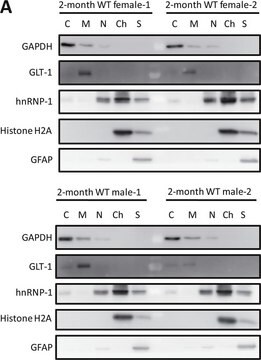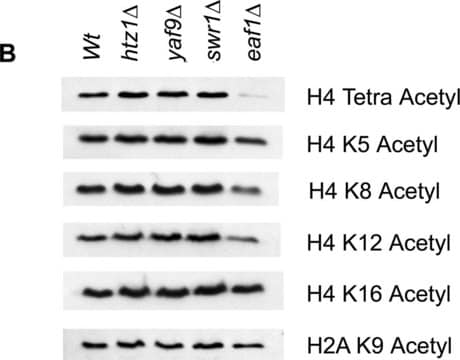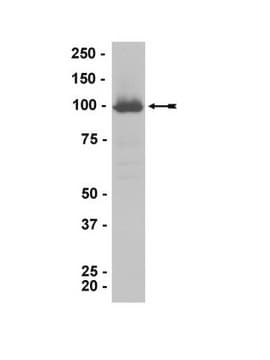07-745-I
Anti-phospho Histone H2A (Ser129) Antibody
from rabbit, purified by affinity chromatography
Sinonimo/i:
Histone H2A.1
About This Item
Prodotti consigliati
Origine biologica
rabbit
Livello qualitativo
Forma dell’anticorpo
affinity isolated antibody
Tipo di anticorpo
primary antibodies
Clone
polyclonal
Purificato mediante
affinity chromatography
Reattività contro le specie
yeast
tecniche
dot blot: suitable
immunocytochemistry: suitable
immunoprecipitation (IP): suitable
inhibition assay: suitable (peptide)
western blot: suitable
N° accesso NCBI
N° accesso UniProt
Condizioni di spedizione
wet ice
modifica post-traduzionali bersaglio
phosphorylation (pSer129)
Informazioni sul gene
Saccharomyces cerevisiae ... Hta1(851811)
Descrizione generale
Specificità
Immunogeno
Applicazioni
Immunoprecipitation Analysis: A 1:100 dilution from a represenetative lot immunoprecipitated phospho Histone H2A (Ser129) from yeast extracts.
Immunohistochemistry Analysis: A 1:1,000 dilution from a lot detected phospho Histone H2A (Ser129) from yeast cells.
Epigenetics & Nuclear Function
Histones
Qualità
Western Blotting Analysis: 0.02 µg/mL of this antibody detected an increase in signal for phospho Histone H2A (Ser129) in MMS treated yeast nuclear extract over untreated yeast nuclear extract.
Descrizione del bersaglio
Stato fisico
Stoccaggio e stabilità
Altre note
Esclusione di responsabilità
Non trovi il prodotto giusto?
Prova il nostro Motore di ricerca dei prodotti.
Codice della classe di stoccaggio
12 - Non Combustible Liquids
Classe di pericolosità dell'acqua (WGK)
WGK 1
Punto d’infiammabilità (°F)
Not applicable
Punto d’infiammabilità (°C)
Not applicable
Certificati d'analisi (COA)
Cerca il Certificati d'analisi (COA) digitando il numero di lotto/batch corrispondente. I numeri di lotto o di batch sono stampati sull'etichetta dei prodotti dopo la parola ‘Lotto’ o ‘Batch’.
Possiedi già questo prodotto?
I documenti relativi ai prodotti acquistati recentemente sono disponibili nell’Archivio dei documenti.
Il team dei nostri ricercatori vanta grande esperienza in tutte le aree della ricerca quali Life Science, scienza dei materiali, sintesi chimica, cromatografia, discipline analitiche, ecc..
Contatta l'Assistenza Tecnica.








